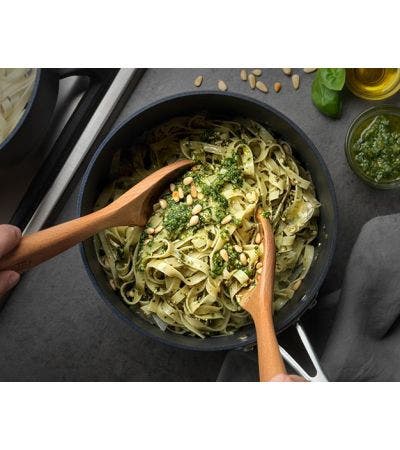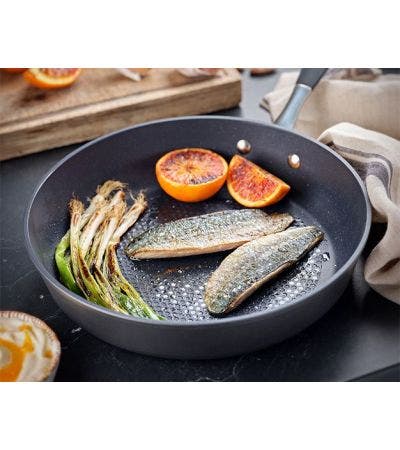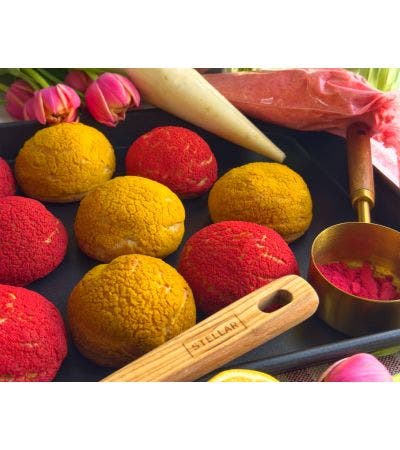Cookware
Why is stainless steel so popular?
Because it is timeless, durable but also hygienic. It has self healing properties: so if you scratch the surface a natural protective layer re-forms stopping corrosion and impurities from taking hold and giving nowhere for bacteria to hide and fester...
Are glass lids safe?
Yes and they allow you to monitor the cooking without lifting the lid. The glass is toughened, like a car windscreen, but in extreme circumstances can break. Glass lids are also suitable for use in the oven. Care should be taken with hot lids as subjecting...
Do stainless steel handles get hot?
Stainless steel is a relatively poor conductor of heat, yet under prolonged periods of exposure to heat they can become too hot to handle, so we always recommend the use of an oven glove or similar.
Stainless steel lid handles and knobs will get hot...
Why are there spots or pitting on the inside of my stainless steel pan?
Ordinary water and food contain salts and acids which can sometimes cause minor markings on the stainless steel surface, particularly on brand new pans. This is common when cooking starchy potatoes or pasta, but the most common cause is adding salt to...
Why is food sticking in my stainless steel frying pan?
The heat is turned up too high. Although certain foods benefit from ‘flash’ cooking the trick is not to move the food for the first few moments. This gives the fibres in the food time to relax and for the temperature of the food to equalize with that...
I have a ‘blister’ on the base of my pan – what should I do?
The most likely cause of the fault is a “hot spot” in the base which has, over time, made the base separate from the pan. A hot spot is where an air bubble has been trapped within the sandwich base when the pan was made. If the bubble is pushing upwards...
Why have my phenolic/plastic handles discoloured or cracked?
These handles typically withstand temperatures up to 180°C and should never be allowed to come into contact with direct heat. For temperatures higher than this the material will start to dry out, crack and even bubble on the surface. If washed for many...
The handle on my pan has broken – what should I do?
Please contact Customer Services who will evaluate whether the problem is covered by the guarantee. We will need to know the brand, range (normally indicated on the base of the pan) and diameter of the pan across the top for replacement handles...
How do I season my frying pan?
Non-Stick frypans although needing a little oil do not need seasoning. If you have an uncoated frypan then the following will help prevent food sticking. Cover the bottom of the pan with cooking oil and heat until the oil begins to smoke. Remove the ...
Can I use my Casserole both on the Hob and in the Oven?
Casseroles are designed for use in both the oven and on the Hob. You can start your Casserole on the hob and then transfer it into the Oven to finish cooking, or Vice Versa. Refer to the specific products specification or care & use for temperature...
Will my old pans work on my new Induction Hob?
We have been manufacturing Induction ready pans since 2002. Any Stainless Steel pan bought prior to this date is unlikely to work on an Induction hob as the pan base would have been made from a non-magnetic steel. A guide is to check the batch number...
Why do I have a bluish ‘rainbow’ marking on my stainless steel?
This is a clear sign that the pan has been over heated. Stainless steel reacts to high heat, by turning a bluey-purple colour (Similar to the colours of a rainbow). It is important that you always match the size of the pan to the size of the ring you...
What's the difference between 1000 an 7000 pots please
Each different number is a different range and they are all different.
For example some are draining saucepans, Some have stainless steel handles and other have stay cool handles, some have non stick coating in them and some are completley stainless...
How do I measure my saucepan?
To measure your saucepan you need to measure across the top of the pan from inside rim to inside rim.
1




